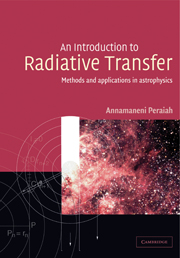Book contents
- Frontmatter
- Contents
- Preface
- Chapter 1 Definitions of fundamental quantities of the radiation field
- Chapter 2 The equation of radiative transfer
- Chapter 3 Methods of solution of the transfer equation
- Chapter 4 Two-point boundary problems
- Chapter 5 Principle of invariance
- Chapter 6 Discrete space theory
- Chapter 7 Transfer equation in moving media: the observer frame
- Chapter 8 Radiative transfer equation in the comoving frame
- Chapter 9 Escape probability methods
- Chapter 10 Operator perturbation methods
- Chapter 11 Polarization
- Chapter 12 Polarization in magnetic media
- Chapter 13 Multi-dimensional radiative transfer
- Symbol index
- Index
Chapter 5 - Principle of invariance
Published online by Cambridge University Press: 05 June 2012
- Frontmatter
- Contents
- Preface
- Chapter 1 Definitions of fundamental quantities of the radiation field
- Chapter 2 The equation of radiative transfer
- Chapter 3 Methods of solution of the transfer equation
- Chapter 4 Two-point boundary problems
- Chapter 5 Principle of invariance
- Chapter 6 Discrete space theory
- Chapter 7 Transfer equation in moving media: the observer frame
- Chapter 8 Radiative transfer equation in the comoving frame
- Chapter 9 Escape probability methods
- Chapter 10 Operator perturbation methods
- Chapter 11 Polarization
- Chapter 12 Polarization in magnetic media
- Chapter 13 Multi-dimensional radiative transfer
- Symbol index
- Index
Summary
Glass plates theory
The most fundamental characteristic of the radiation field in dispersive media such as stellar atmospheres, planetary atmospheres, planetary nebulae is the diffuse radiation which arises from multiple scattering of radiation by the media. This has been studied through an approach called the principle of invariance, or invariant imbedding, due to Ambarzumian (see books by Chandrasekhar (1960), Sobolev (1963), Kourganoff (1963), Wing (1962), Preisendorfer (1965)). Bellman and his collaborators have published several papers on this subject (see the bibliography at the end of the chapter). Before we study this principle, we shall see how the concept was developed by Sir George Stokes in his glass plate theory (1852, 1862). In remarkably simple papers, he derived the transmission and reflection factors when a ray of light passes through a system of glass plates. We shall see below how he obtained the principle of invariance of reflectance when several glass plates are arranged parallel to each other, one on top of the other.
He obtained difference equations for the reflection of radiation by a pile of identical glass plates and derived certain commutation relations for sets of glass plates. It is remarkable that he was able to obtain transmission and reflection factors which look similar to those obtained in more complicated media such as stellar atmospheres. We shall derive the transmission and reflection factors for the set of glass plates following the treatment given in Hottel and Sarofim (1967).
Information
- Type
- Chapter
- Information
- An Introduction to Radiative TransferMethods and Applications in Astrophysics, pp. 112 - 145Publisher: Cambridge University PressPrint publication year: 2001
